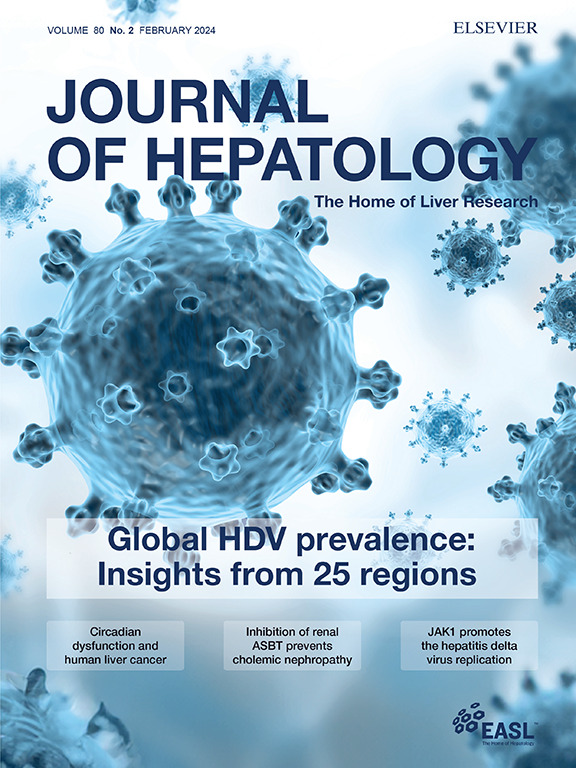Dissecting metabolic dysfunction- and alcohol-associated liver disease (MetALD) using proteomic and metabolomic profiles
IF 33
1区 医学
Q1 GASTROENTEROLOGY & HEPATOLOGY
引用次数: 0
Abstract
Background
& Aim, Metabolic dysfunction associated and alcohol associated liver disease (MetALD) is a poorly understood condition that bridges cardiometabolic and alcohol-related pathological characteristics. We aim to distinguish MetALD patients who share similar molecular signatures with alcohol-related liver disease (ALD) and those share signatures with metabolic dysfunction-associated steatotic liver disease (MASLD), and assess their prognostic risk for complications and mortality.Methods
Our analysis involved 443,453 European participants from UK Biobank, including 34,147 with MetALD, 11,220 with ALD, and 124,034 with MASLD. We employed Elastic Net Regression to classify ALD and MASLD involving 249 plasma metabolites and/or 2,941 plasma proteins with various sensitivity analyses. We then used the selected concise model in MetALD patients to identify alcohol-predominant group (classified to ALD) and cardiometabolic-predominant group (classified to MASLD). Finally, we explored their 15-year risk of major outcomes (i.e., heart failure, myocardial infarction, stroke, cirrhosis, hepatocellular carcinoma and mortality) using Cox regression.Results
The metabolome alone discriminated ALD from MASLD with an Area under the Curve (AUC) of 0.86, while the proteome alone achieved an AUC of 0.96. Adding age, sex, BMI, liver enzymes, or metabolome information did not enhance the AUC of the proteome model. A ten-protein model differentiated ALD and MASLD with an AUC of 0.93. This model identified that alcohol-predominant MetALD patients had significantly higher risks of mortality, and cirrhosis, along with elevated fibrosis scores and higher fibrosis stages, compared to cardiometabolic-predominant patients.Conclusions
This study emphasizes the importance of subtyping differentiation using proteome data for personalized treatment and improved prognostic outcomes in MetALD patients.

利用蛋白质组学和代谢组学分析代谢功能障碍和酒精相关肝病(MetALD
Background&目的:代谢功能障碍相关和酒精相关性肝病(MetALD)是一种鲜为人知的疾病,它连接了心脏代谢和酒精相关的病理特征。我们的目的是区分与酒精相关肝病(ALD)和代谢功能障碍相关脂肪变性肝病(MASLD)具有相似分子特征的MetALD患者,并评估其并发症和死亡率的预后风险。方法纳入来自UK Biobank的443,453名欧洲参与者,其中34147名患有MetALD, 11,220名患有ALD, 124,034名患有MASLD。我们采用弹性网络回归对涉及249种血浆代谢物和/或2941种血浆蛋白的ALD和MASLD进行分类,并进行各种敏感性分析。然后,我们在MetALD患者中使用选定的简明模型来确定酒精优势组(分类为ALD)和心脏代谢优势组(分类为MASLD)。最后,我们使用Cox回归分析了他们15年主要结局(即心力衰竭、心肌梗死、中风、肝硬化、肝细胞癌和死亡率)的风险。结果单独代谢组鉴别ALD和MASLD的曲线下面积(AUC)为0.86,单独蛋白质组鉴别ALD和MASLD的曲线下面积(AUC)为0.96。添加年龄、性别、BMI、肝酶或代谢组信息并没有提高蛋白质组模型的AUC。10蛋白模型区分ALD和MASLD的AUC为0.93。该模型发现,与以心脏代谢为主的患者相比,酒精为主的MetALD患者具有明显更高的死亡率和肝硬化风险,同时纤维化评分升高和纤维化分期也更高。结论:本研究强调了利用蛋白质组学数据进行亚型分化对MetALD患者个性化治疗和改善预后的重要性。
本文章由计算机程序翻译,如有差异,请以英文原文为准。
求助全文
约1分钟内获得全文
求助全文
来源期刊

Journal of Hepatology
医学-胃肠肝病学
CiteScore
46.10
自引率
4.30%
发文量
2325
审稿时长
30 days
期刊介绍:
The Journal of Hepatology is the official publication of the European Association for the Study of the Liver (EASL). It is dedicated to presenting clinical and basic research in the field of hepatology through original papers, reviews, case reports, and letters to the Editor. The Journal is published in English and may consider supplements that pass an editorial review.
 求助内容:
求助内容: 应助结果提醒方式:
应助结果提醒方式:


